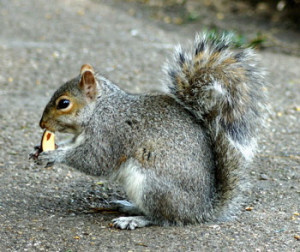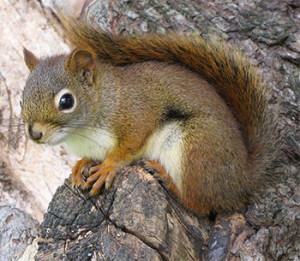Red Squirrel or Gray Squirrel?
By Chris Williams on October 10, 2014.
What’s the difference between a red squirrel and a gray squirrel? We seem to have one or the other trying to chew its way into our attic. A. W., Hooksett, NH

Gray Squirrel

Red Squirrel
Both of these squirrels are found in New Hampshire and Massachusetts, and either is capable of chewing into your attic. Gray squirrels adapt better to being around people, and often invade attics. Red squirrels are more reclusive and nest in unoccupied structures more often than in occupied structures.
The Body Color is a Clue
If you’ve seen the offending squirrel, you should be able to tell by its fur color which squirrel you are dealing with. The red squirrel is rusty brown on its back with a white or gray belly. The gray squirrel is gray (or “grey” if you prefer) on its back, also with a white belly and throat. The red squirrel is smaller (10-15 inches long, including tail) than the gray (15-20 inches), although that’s not much help unless you can get it to pose next to a ruler, or have the two side by side.
The Surrounding Trees Are a Clue
Maybe the biggest clue to which squirrel you have is the location of your home. You are obviously in a wooded area since squirrels and trees go together. Are you surrounded by conifers like pine, spruce, or fir, or are hardwoods your main trees? Red squirrels are found in coniferous forests because their primary food is the cones from these trees. In fact, if a red squirrel does end up in your attic, you will probably find a pile of broken up tree cones there as well. Gray squirrels prefer nuts found in hardwood forests, especially from oak and hickory trees. If you have both hardwoods and conifers on your property, this isn’t much of a clue at all.
Red or gray, you already know that you have a potentially serious squirrel problem. See Squirrels Can Make a Mess of Your Attic to find out what you’re in store for. Now is the time to take care of it by blocking the squirrel’s attempts to get inside. Exclusion, or squirrel-proofing, is not something that you want to try on your own. If you’re not careful, you can seal a squirrel (or her babies) inside your attic.
Call a licensed nuisance wildlife expert like our team of techs at Colonial. Lucky for you, we specialize in exclusion measures that keep squirrels from getting into your attic (see Squirrel-proofing Your Home). We seal existing openings and screen or reinforce areas that squirrels target to keep them from becoming new openings. And, our exclusion work is guaranteed. Take advantage of our expertise; give Colonial a call today!
Gray squirrel photo: Martin Pettitt / Foter / CC BY
Red squirrel photo: Photo credit: Gilles Gonthier / Foter / CC BY